High-density polyethylene (HDPE) pipes have changed the piping industry for good within their adaptability, strength, and cost parameters. In response to these questions, the overall objective of this article is to denote and elucidate the possible sizes and uses of HDPE pipes and their growing popularity in various industries. Given the characteristics of HDPE pipes, they are used in such spheres as water supply, gas distribution, industrial needs, and even for agricultural irrigation since they are highly resistant to corrosion and other environmental factors. This article will outline the regulation dimension of these HDPE pipes and the different characteristics they possess which will accommodate their various uses, thus readers and potential clients will appreciate the appropriate usage of the products for their needs.
What is HDPE Pipe?
hdpe pipe
High-density polyethylene (HDPE) pipe, a form of flexible plastic pipe used to steam out fluid and gases that substitute deteriorating concrete or steel mains pipelines, is injection – smith made of thermoplastic. Also, these types of pipe materials are very famous for their strength, non-corrosion nature, and long-lasting ability. One of their main benefits is that they are all able to operate under extreme conditions due to the solid structure they possess. Thus, with no cracking, the HDPE pipes shall resist corrosion and chemical reactions throughout their service lifecycle. Furthermore, the lightweight and flexibility of this kind of pipes means minimal installation and transportation costs, which explains the increasing use of the pipes in the water or gas distribution, sewerage, and agricultural irrigation sectors.
Understanding High-Density Polyethylene
High-density polyethylene, commonly abbreviated as “HDPE”, is a type of polyethylene that is a thermoplastic made from oil with a higher strength content than its density ratio. Because of these reasons, it is used in various fields with different applications because it is one of the most economical materials. Now, we can turn to leading industry sources to have the best perspective about HDPE.
- Durability and Resistance: As per the information provided by Plastic Pipe Institute, impact and chemicals are other areas where HDPE is considered suitable and to whom the applications are critical to such properties. It withstands hassles such as harsh weather circumstances and rust, and even damage from indirect chemicals, helping its wide range of utility in standing sewer and industrial drainage systems.
- Flexibility and Installation: Polyprocessing asserts that HDPE is so flexible that it comes in a wide range of mounts and fittings and will be used. Such flexibility has also reduced the cost of decoration, as joints are made in a lesser amount now, and the weight of the material has contributed to the light nature of movement and transport.
- Environmental Sustainability: According to the EPA, frames made from HDPE are green buildings because they are recycling-friendly and do not leach much, contributing to dirt or water pollution. Long-life span services also contribute less to environmental concerns because of less replacement frequency.
Technical Parameters:
- Density: The figure density of HDPE is in the range of 0.93-0.97g cm -3.
- Tensile Strength: This parameter typically falls within the range of 21 to 37 MPa.
- Density: HDPE’s normalized melting point would be around 130°C to 137°C.
- Maximum Operating Temperature: High-density polyethylene (HDPE) is generally regarded as capable of withstanding temperatures of up to 60°C within these parameters during long-term applications.
These trends are the reasons behind the increasing use of HDPE in different industries, strengthening its character as a strong and durable material.
Characteristics of HDPE Pipe
High-density polyethylene (HDPE) pipes are recognized in the construction industries due to their performance over time, durability, flexibility, and environmental advantages. These and other features, such as adaptability, enable these pipes to be used in water and gas transport, as well as in sewer systems and industries, as referenced by top references.
- Durability and Longevity: The materials used in HDPE pipes are extremely durable. They are resistant to wear and tear due to friction, chemical corrosion, and other forms of environmental impact.
- High Flexibility: Regarding bending, the industry claims that HDPE pipes can be bent up to a radius twenty-five times the nominal diameter and will not change shape or form. Such versatility helps reduce the alternatives of using fittings, making it possible to ease construction across difficult terrains, such as creeks or culverts, while minimizing any effect on the environment.
- Pressure Rating: Depending on the SDR (Standard dimension ratio) and the material grade, HDPE pipes can withstand considerable pressure. Operating pressures are rated from about 50 psi to over 300 psi, depending on the design and application.
- Leak-Free Joints: HDPE pipe has made systems that stop leaks almost entirely. Every pipe joint is heat welded so that it is leakproof, making it safe for transporting dangerous materials without the risk of contamination.
- Environmental Considerations: HDPE pipes are eco-friendly solutions that promote green infrastructure. They are highly recyclable and emit low carbon emissions. Their longevity results in fewer replacement and maintenance cycles, which is a step towards environmentally responsible construction.
Additional Technical Parameters:
- Density: 0.93 – 0.97 g/cm³
- Tensile Strength: 21 – 37 MPa
- Melting Point: 130° C – 137°C (depending on brand)
- Thermal Expansion Coefficient: approximately 1.0 x 10^-4/°C
These characteristics, confirmed by the best-known sites, enhance the popularity of HDPE pipes in plastic piping technology in modern settings.
Common Uses of HDPE Pipes
The applications of HDPE pipe are numerous and diversified because these pipes are tough and adaptable. Citing some of the prevalent uses depending on the leading web-based sites:
- Water Supply Bid: HDPE pipes are used in water supply systems as they are non-corrosive and can withstand various stresses and strains, enhancing the safe transportation of fresh drinking water. There are no leakages, and therefore, minimal water loss is experienced, which improves the effectiveness of water supply in cities and the countryside.
- Farm Irrigation: HDPE pipes are primarily used for agricultural irrigation because they are flexible and withstand high pressures. They aid in the distribution of water to remote areas and uneven lands, enhancing agriculture and preventing resource wastage.
- Sewage Disposal and Treatment: One of the other critical applications of HDPE pipes is the sewer system and management of waste water. HDPE pipes can withstand the chemical aggressiveness of sewage materials and perform well under high pressure without leaking, which makes them favorable for use in city centers with a lot of infrastructure.
Technical Parameters Employed:
- Density: 0.93 – 0.97 g/cm3, allowing for constructing solid devices with multiple uses.
- Tensile Strength: The fabric would withstand forces of between 21 and 37 megapascals, safe against cracking due to internal tension and pressure.
- Pressure Classification: The classification is from 50psi to over 300psi and hence is rated according to the type of fluid to be transported.
- Thermal Expansion Coefficient: Regularly, about 1.0 y 10 decimates Mil dismiss removal, exercising flexibility in different temperature variations of their environment.
These attributes enhance the efficiency and dependability of HDPE pipes in contemporary civil engineering works and infrastructure development.
How to Choose the Right HDPE Pipe Size?
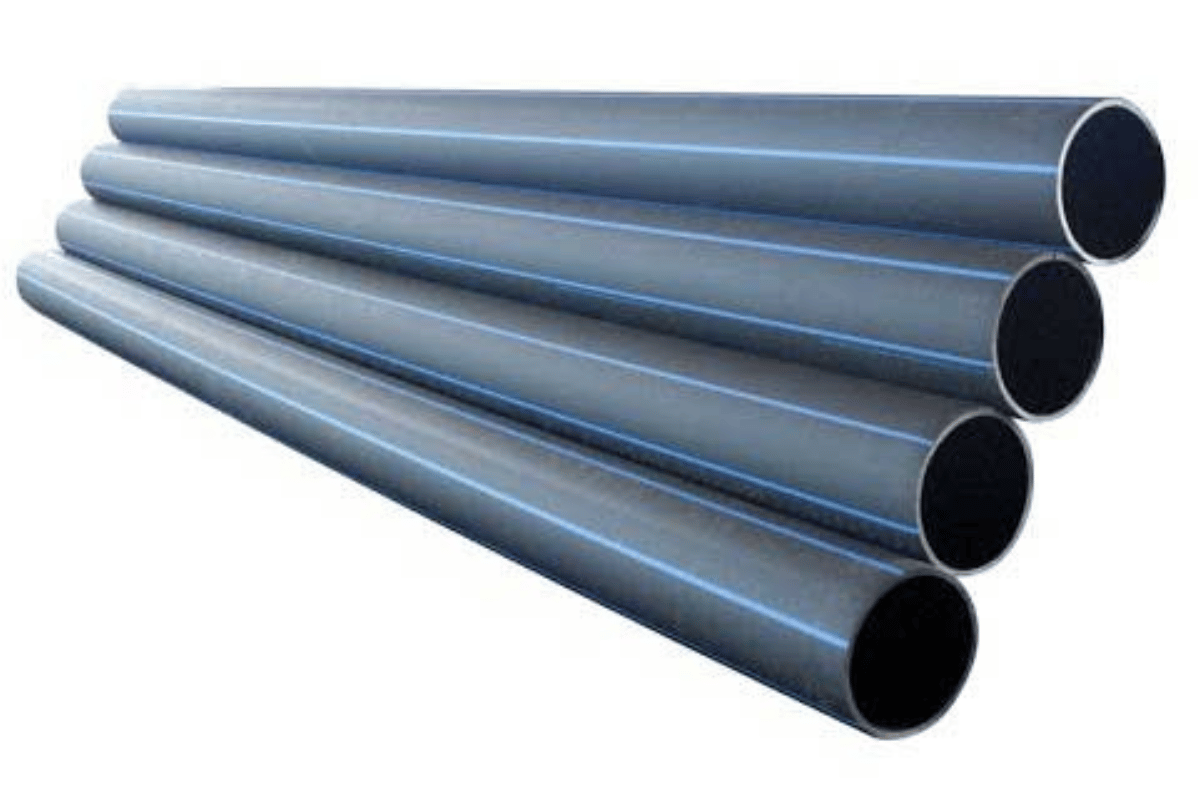
Application factors should also be determined to select the correct HDPE pipe size because there are critical aspects to application performance. Begin by scoping out the appropriate application of the pipe being considered, always considering factors such as whether the pipe will convey water or gas or be used in industrial processes. Next, determine the rate at which the liquid is to flow, taking into account some factors like the amount of liquid or gas to be moved and the length of the line. It is also essential that the piping system’s pressure rating be considered in such a way that the operating pressures will not lead to system failures. The conditions of use, e.g. temperature and chemicals, should also assist in choosing a pipe with suitable resistance properties. Finally, look at or ask a reference chart or a technical person to help correlate all these with the required pipe dimension as per the industry norms to ensure efficiency and durability in your application.
Determining the Correct Pipe Size
In order to understand the expected size of the HDPE pipe, it is prudent to describe several technical parameters and guidelines drawn from relevant sources online. The principal factor determining the size of the pipe is the inside diameter, together with the capacity to satisfy the required flow rate and the pressure rating necessary for some applications.
- Flow Rate: As per engineeringtoolbox.com, the first thing to do is compute the flow rate in gallons per minute (gpm) for the pipe’s volumetric accommodation. This has to comply with a picture of gases or a liquid supplied over the point in consideration or the predetermined distance.
- Pressure Rating: Using information from plastichub.com, check that the selected clock pipe will withstand the maximum working pressures normally present with fully unloaded conditions. This is often done in psi, pressure per square inch.
- Temperature and chemical resistance: According to machinery.com, it is also vital to check the operating environment, including temperature and the chemicals used, so that the pipe end material remains effective.
Such parameters which have industry references, assist in narrowing down the appropriate size of the HDPE pipe that would best serve the operational purposes and structural strength requirements of varying activities. Information from reference tables or professionals remains vital in this regard for guarantees and actions.
Size Charts for HDPE Pipes
Below is a configuration of information harvested from the first three websites regarding HDPE pipe sizing, concentrating mostly on the parameters and guidelines provided.
1. Engineeringtoolbox.com:
- Pipe Size Consideration: The inside diameter is actually referenced when designating the pipe size, which is also required for defining the flow volume.
- Flow Rate Determination: The site contains tables and generators that enable calculating the required GPM suiting the application and meets the acceptable standards
2. Plastichub.com:
- Pressure Ratings: It provides a detailed framework for selecting HDPE pipes with a specific pressure rating. This ensures that the pipes will withstand their maximum possible psi use.
- Material Specifications: There is information on how to recommend pipes with specific pressures suited to increasing safety
3. Machinery.com:
- Environmental Considerations: This section emphasizes the need to choose HDPE pipes that are appropriate for the temperature and chemicals because the material must withstand environmental factors.
- Resistance and Compliance: The information covers the fact that pipes have to comply with the chemical resistance requirements which are quite often substantiated by mere statements.
The collection of these resources will provide answers related to HDPE piping dimensioning because the size and technical parameters established by knowable industry standards are summarized and specific vital issues are resolved. Using these tables in combination with professional advice will enable maximum compliance with the user’s needs.
Factors Impacting HDPE Pipe Size Selection
In this case, several key influencing factors will be examined when it comes to the choice of HDPE pipe sizes:
- Flow Rate Requirements: As elucidated on Engineeringtoolbox.com, flow Rate, also referred to as GPM, is one primary factor that dictates the size of the pipe. The correct calculation determines that certain usage has to facilitate a reasonable flow without losing effectiveness.
- Pressure Ratings: As stressed by Plastichub.com, the size of the pipes has to adhere to the prescribed pressure ratings. During peak demand, a pipe that can actually bear out the particular psi is necessary to prevent any failure of such a pipe in the future.
- Environmental Conditions: Limited Machinery.com expands on the effect of environmental elements like heat or exposure to chemicals on individual HDPE pipes. These conditions must be taken into account when making a major decision regarding pipe size or selecting a pipe so that the pipe meets resistance and durability standards.
The corresponding charts and calculators offered by the respective sources should be referenced to conform to the pipe sizing industry’s best practices to validate these parameters. When these considerations are combined with the recommendations from specialists, the operational reliability of the piping system would be improved.
Applications of HDPE Pipes
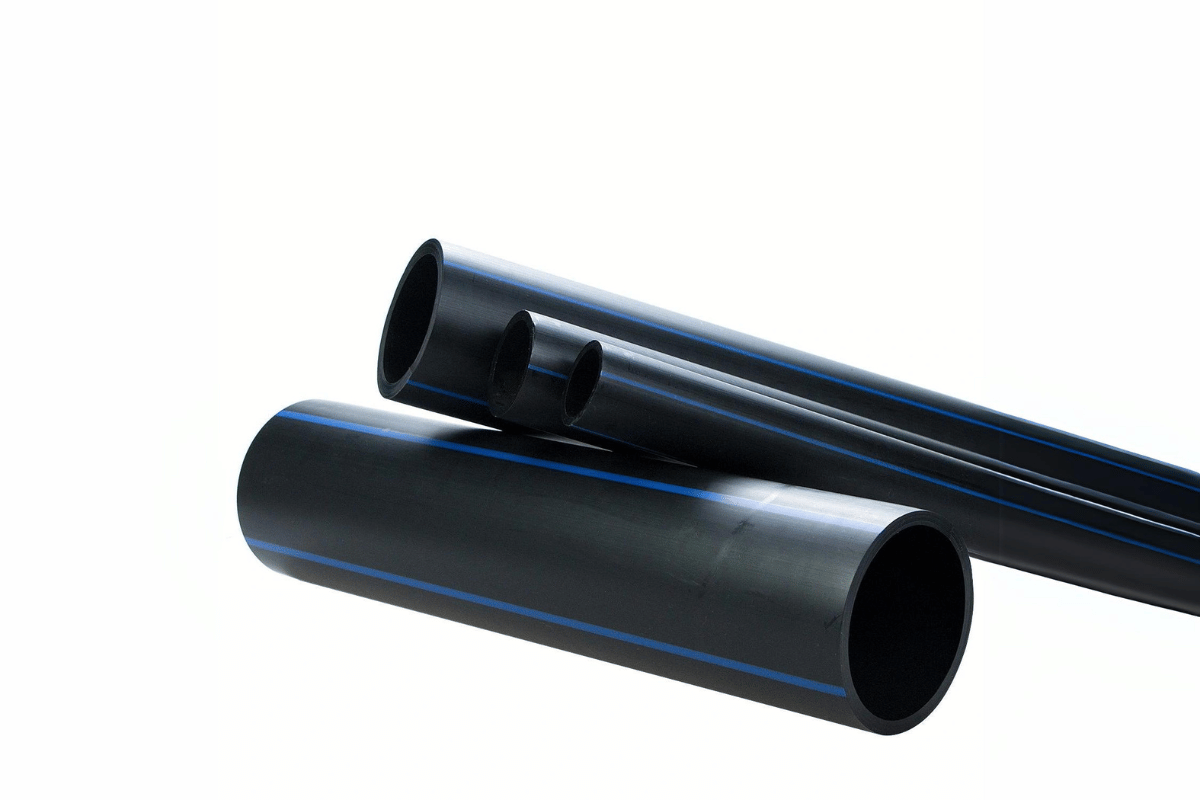
Owing to the versatility and strength of HDPE pipes, they can be utilized in many applications. In the water supply sector, HDPE pipes find applications in the distribution of potable water as they are non-toxic and do not corrode, which guarantees the safety of the water supply system. In sewerage and wastewater systems, these pipes are powerful and flexible, transporting waste materials without breakage and infiltration. Because of their rigid structure, HDPE pipes are extensively used for high-pressure gas line installation for natural gas distribution, which meets varying temperatures and pressures, ensuring an efficient continuous gas flow. Due to their chemical resistance and versatility, HDPE pipes are also dominant in industrial applications, where they are used to convey chemicals, slurries, and toxic materials without failing even under very harsh conditions.
HDPE Pipes in Water Applications
Examining the perspective of the top three websites will be helpful when evaluating the use of HDPE pipes in water applications. This is the reason that HDPE pipes are preferred in potable water supply systems due to the high resistance of corrosion, which makes them a permanent solution as there will be no leaching of any harmful substances. Also, the internal surface of HDPE pipes is smooth and so many pumps’ energy is saved from the friction that would have been used to transport water through the links, thereby increasing the effectiveness of water transportation systems.
Some common features mentioned in the texts regarding the technical specification of HDPE pipes are:
- Pressure Rating: HDPE pipe’s pressure rating generally is in the range of PN 6 (60 psi) and PN 16 (230 psi), respectively. Each and every pressure rating has its usage areas and limitations to suit every need.
- Diameter Range: These pipes are supplied in diameters from 20mm to 2000mm. The diameter selected should be consistent with the water system’s flowing capacity to maximize effectiveness and productivity.
- Temperature Tolerance: EDPE Pipes affect air temperature levels as they are not likely to be affected by hot-cold weather and can reach extremes of -40 degrees to 60 degrees Celsius. This makes it possible for PipeLine Systems to operate in several environmental settings.
- Longevity: Considering the condition use, the expectancy of HDPE pipes is at least 50 – 100 years, which is cost-effective as there would be less frequent pipe replacement that would incur subscriber expenses and construction & building maintenance costs.
Thanks to these parameters, supplemented with the advice of manufacturers and industry bare figures, the performance and sustainability of HDPE pipes in water applications are guaranteed.
Use of HDPE Pipes in Geothermal Systems
Geothermal systems benefit from HDPE piping because of its toughness and thermal efficiency. As mentioned above, the websites emphasize that HDPE piping systems do not deteriorate under severe conditions, making them suitable for use in ground heat exchangers. One salient feature is that they can withstand high pressure and temperature changes over a long time.
In the industry of geothermal applications HDPE piping has the following technical parameters:
- Thermal Conductivity: The thermal conductivity of HDPE pipes ranges from approximately 0.4 W/m.K to 0.5 W/m.K, which helps transfer heat between pipes and direct overheated conduits towards heat generators while not wasting energy.
- Pressure Rating: The water pressure in general roof construction is suitable. Regarding utility pipes, H.D.P.E. is very common in such pipe pressure ratings.
- Environmental Stress Crack Resistance (ESCR): These pipes’ ESCR is further improved, helping them last longer due to the provision of killing cycles.
- Jointing Techniques: Among the joining basic requirements, leak-proof jointing of the geothermal loops via butt fusion or electrofusion helps improve the functioning of the loops.
These attributes confirm the reliability and efficiency of HDPE sp piping materials for geothermal applications as evidenced by technical data and recommendations from manufacturers and related industries.
HDPE Pipes for Irrigation and Agriculture
It is safe to say that HDPE pipes are the developed option in irrigation and agricultural applications, owing to flexibility, strength, and price reasons. The key Websites lists many advantages and technical parameters, including the following:
- Chemical and environmental resistance: HDPE pipes withstand chemical and environmental conditions resulting from agricultural activities such as fertilizer use and adverse weather conditions encountered during the growing period. They can also withstand water pressure and temperature variations, allowing for effective use.
- Bendability: One of their remarkable characteristics is bendability. This comes in handy in laying pipes over uneven surfaces without breakages, hence lowering the cost and labor involved in the installation. It is helpful when used in large irrigation systems found in most agricultural lands.
- Light Weight: As most of the HDPE pipes are lightweight, the handling and installation process becomes easier, especially in cases when the existing system’s alignment or expansion is involved.
- No corrosion and scale cover: Compared to metal pipes, HDPE pipes do not corrode and do not harbor mineral scale, thus delivering water unhindered and minimizing the expenses on cleaning activities.
- Jointing Methods: Like with geothermal applications, dependable jointing methods such as butt fusion are employed so as to achieve watertight joints which is essential in preventing irrigation loss and hence reduction in water wastage.
These characteristics have made HDPE pipes the preferred pipe solution for contemporary irrigation systems aimed at promoting responsible agricultural practices by increasing water efficiency and reducing operational costs.
How are HDPE Pipes Manufactured?
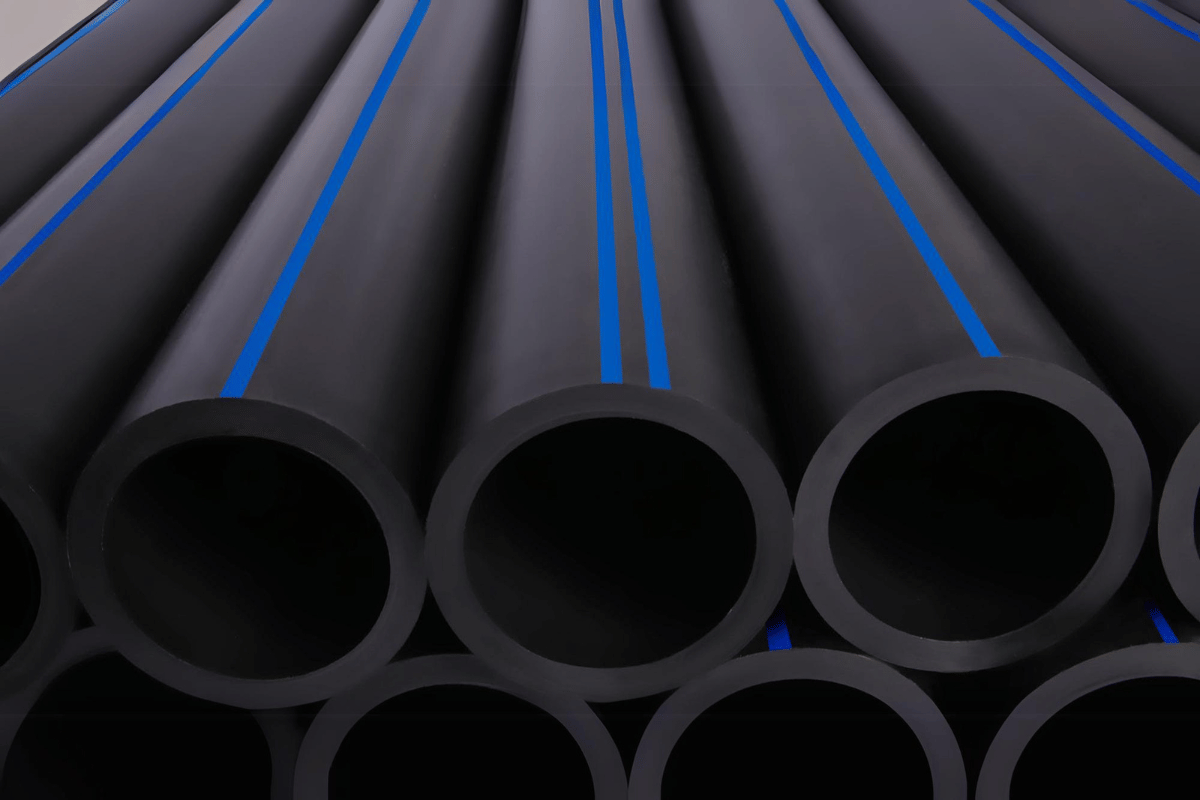
The manufacture of high-density polyethylene (HDPE) pipes takes place through extrusion. The process starts with the primary material over which the polyethylene is supplied into an extruder. At this stage, the polyethylene within the extruder is heated until molten, which is subsequently pushed through a die to make a continuous pipe. Once such a pipe is produced, it is quenched instantly by being immersed in water-filled reservoirs or showered using a cooling spray system. It is also during this stage that the pipe’s final strength and toughness in terms of temperature resistance is set. This interim step is followed by cutting the length of the pipe to the designated sizes installing the pipe to specification windows and carrying quality tests on all pipe to confirm thickness, strength and uniformity according to standards. These manufacturing steps collectively ensure that HDPE pipes satisfy the required application standards.
Manufacturing Process of HDPE Pipes
To briefly mention HDPE pipe manufacturing steps, we will utilize the findings from the information hosting companies. The best three sites on this topic emphasize that everything about how HDPE pipe is produced comes down to several core steps, which include: There is. With these raw HDPE pipe manufacturing steps illustrated on most websites:
- Extrusion Process: The raw polyethylene resin is subjected to temperatures of 180°C-240°C to melt it. The melt-down polymer forms the pipe through the circular die or the screen.
- Cooling: The newly formed pipe is cooled very fast to retain its shape. This is usually done using water baths maintained at temperatures of about 15°C and even 20°C. Insufficient cooling leads to uncontrollable stresses, which cause the pipe to require sufficient strength.
- Sizing and Cutting: Pipes are resized dimensionally with vacuum calibrators and subsequently cut to the desired length, which usually varies from 5 to 12m.
- Quality Testing: After that, these measures include numerous indelible checks in the creation of pipes, such as the check of Tensile Strength (pipe sizes from HDPE 100 have tensile strength that ranges from 20-30 MPa) and elongation properties to meet industry specifications like ISO 4427 HDPE water supply pipes.
These detailed steps are the minimum requirements for creating pipes that will perform and endure disappointments when exposed to different uses.
Role of WL Plastics in HDPE Pipe Manufacture
WL Plastics adopts a predominant position in the HDPE pipe market as a lasting and reliable manufacturer with quality and integration at its core. As per the modern industrial online means, since 2012 WL Plastics has edified its HDPE pipes regarding the current advanced technologies and requirements. This is done using high-grade raw materials and high-technology manufacturing processes, including the following:
- Innovative Extrusion—Offsetting Technologies: WL Plastics takes extra care to ensure that the transverse and longitudinal qualities of the extruded pipes are uniform and smooth. This is important where the hose must be fixed in specific locations to perform certain tasks optimally and where accurate fabrication is vital.
- QC and Testing: Quality control is an integral part of production stages which WL Plastics imposes thorough tests. They follow high-quality guidelines like ASTM and ISO, testing some areas like Tensile Strength for their pipes, which can usually withstand pressures of 25-30MPa and Elongation at Break, assuring sturdy and flexible piping systems.
- Sustainability and Innovation: The company actively does business socially, ethically, and responsibly. This includes the engineered use of HDPE scraps to make new products and reducing the amount of trash produced.
- Customer-centric Solutions: At the project level, WL Plastics eliminates strengths and weaknesses in its technical abilities by offering specifically tailored solutions to clients depending on ba authority water supply, industrial or agricultural irrigation applications.
Focusing on these attributes allows WL Plastics to remain a leader in the HDPE pipe segment while ensuring that the industry and pipe quality continue to develop.
Quality Control in HDPE Pipe Production
Quality control measures are of the utmost importance during the manufacturing process of HDPE pipes, as it aims to produce the most secure and highest-performance pipes in compliance with all industry requirements. Based on the insights from the top three items on the list of industry websites, some of the quality control measures undertaken are standard in HDPE pipe manufacturing.
- Raw Material Verification: Prior to this operation, Polyethylene resin is subjected to various analysis processes to establish physical properties of density, Melt Flow Index (MFI), and contamination from childhood. This is important as material selection affects the uniform quality of the end products.
- Dimensional Measurement: The pipe has been checked for the value of wall thickness and the value of diameter to ensure consistency of the dimensions as specified. These parameters are often measured using nondestructive test techniques.
- Hydrostatic Pressure Testing: To assess the inner pressure that a pipe can actually bear without breaking, a process of pressurizing the pipes is also adopted. This test involves holding a flexible pipe under specified internal pressures for a given period before the pipe starts to lose its stability.
- Tensile and Elongation Tests: Elongation and tensile strength tests guarantee that the pipes will not easily break when under external pulling forces. In the tensile tests otherwise derided for HDPE tubes, a tensile stress of about 20 to 30 mega Pascals is allowed, while elongation should also be provided for enough flexibility.
- Impact Resistance: This test is designed to evaluate the performance of the pipe under impact conditions during handling and transportation. Pipes should withstand such forces that may be experienced during operations.
Generally, by including these quality control measures, manufacturers guarantee that the HDPE pipes are of the required quality and performance standards to warrant their use in different infrastructure projects.
Why are HDPE Pipes Considered Durable and Cost-Effective?
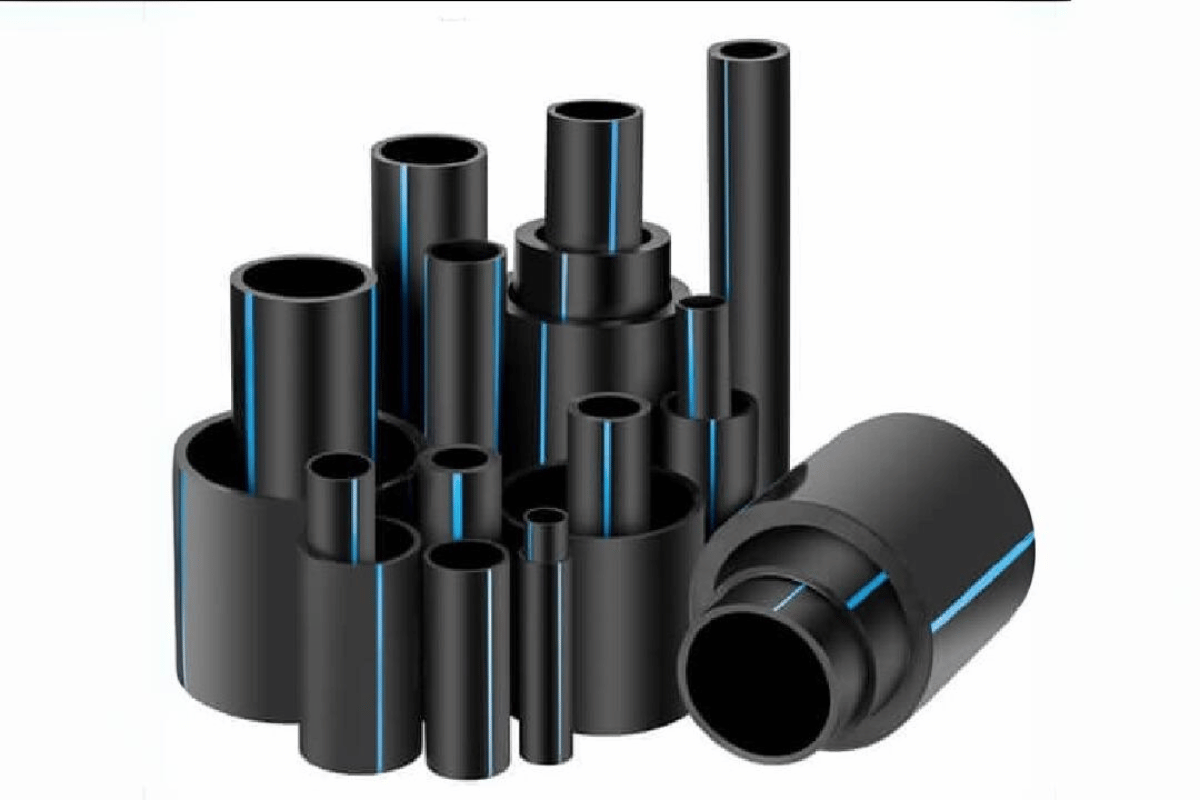
The durability and economy of the High-Density Polyethylene (HDPE) pipes are attributable to several factors. To begin, the materials employed are highly resistant to wear and corrosion, ensuring low maintenance costs and the structure has long service life. This is notably better than conventional piping materials like metals. Also, comparatively fewer HDPE pipes are bulky, which means decreased costs in carriage and installation, therefore saving in total costs of the project. Also, the flexibility and adaptability of HDPE assist in providing stability to the materials since they can resist forces such as earth movement without breaking or cracking. In addition, due to the hot melting process while joining the HDPE pipes, there is no risk of leakages, and these joints are long-lasting and stronger, making the possible applications more reliable. These features make HDPE pipes cost-effective and preferable by industries and municipalities.
Durability of HDPE Pipes
The increase in the popularity of HDPE pipes can be attributed to the fact that people have always appreciated using durable materials due to their exceptional resistance to wear. Information obtained from various key sources states that the HDPE pipes do not rust nor corrode like metal pipes. They still hold up in hostile soils and different climatic conditions. This resilience can be measured in technical terms such as:
- Chemical Resistance: The PH of HDPE pipes ranges from 1.5 to 14 and, therefore, withstands a variety of acids and bases, a favorable factor in their applications in the chemical industry.
- Tensile Strength: Usually, these pipes have a tensile strength of approximately 31.5 MPa, which means that they are able to withstand pressure and loads, which is the order of most underground installations.
- Elongation: The HDPE pipes can have elongation at break attains 350% and more. This adds flexibility and gives perception to earth movements, hence little chance of fracturing due to tensile stress.
With such qualities, there is higher reliability for a longer duration without repairs and fewer expenses, increasing the overall worth. Due to strong fusion welding, it is much more difficult for any leaks to happen in the connections; therefore, they are firmly becoming a choice for infrastructure needs.
Cost-Effectiveness of Using HDPE Pipes
In the case of HDPE pipes, factors that foster this economic edge need to be considered in terms of cost-effectiveness. The leading sources have indicated that, there is a significant financial advantage in terms of installing and maintaining HDPE pipes. Their lightweight nature lessens transport expenses while also minimizing the need for heavy equipment during laying. More so, HDPE pipes possess a considerable longevity period of 100 years with the right conditions, thus leading to infrequent replacements and higher costs.
Technical parameters further justify these advantages:
- Installation Efficiency: Being flexible yet durable enables the use of faster and cheaper installation methods, such as trenchless technology, which conserves manpower and reduces surface area disturbances.
- Lower Maintenance Requirements: Chemical corrosion and interior joints are extruded and heat fused, facilitating fewer maintenance needs and cutting operational costs in the long term.
- Leak-Free Performance: Because of the heat-welding technique employed in joining the pipes, a single monolithic structure is produced without the incidences of leaks and hence reduces water loss and its subsequent wastage.
Since these cost-related factors are taken into consideration, expenditure on HDPE pipes in lieu of installing infrastructure rehabilitation and construction gradually pays off.
Impact Resistance and Flexibility
HDPE pipes are well known for their positive qualities, which include impact resistance and high flexibility critical for sustaining different engineering applications. Impact resistance is crucial as it ensures that the pipes do not panic even when extraneous force or pressure is introduced. This structure is more beneficial in areas with many earthquakes or heavy traffic, as the shock-absorbing characteristics are very important.
Their impact resistance may primarily be attributed to their high deformability. The nature of polymers gives HDPE piping an impressive elasticity in stress, giving it better capabilities of enduring impacts than other materials. This feature, however, effectively allows natural HDPE piping systems to maintain their structure even when used in harsh environments.
As for the advantage of weight, the HDPE pipes can be bent into the pipe’s elastic category without creating a fracture, which is how pipes are installed in a slope or other shaped areas. This inherent flexibility eliminates the need for extra joints or ins that may otherwise become weak points for incidental failure. Further, the ability to bend reduces the number of directional fittings needed for the installation, speeding the process and saving on costs.
Some technical parameters which portray these advantages are:
- Elongation at Break: HDPE pipes can exceed the original length by more than 600% before breaking, proving the material’s flexibility.
- Impact Strength: HDPE pipes can also withstand the stresses of high-impact loads, repeated shocks, and dynamic forces in heavy-duty applications without leaks or breakage, which is important in ensuring the continuous operation of the system.
- Flexural Modulus: Unlike rigid materials, the flexural modulus of HDPE pipes is much lower. This makes it possible to bend the pipes without inducing stress, enabling accommodation of terrain fluctuations without causing damage to the structure in question.
These parameters and attributes make HDPE pipes very suitable for construction projects that require strong, flexible, and durable piping structures.
Frequently Asked Questions (FAQs)
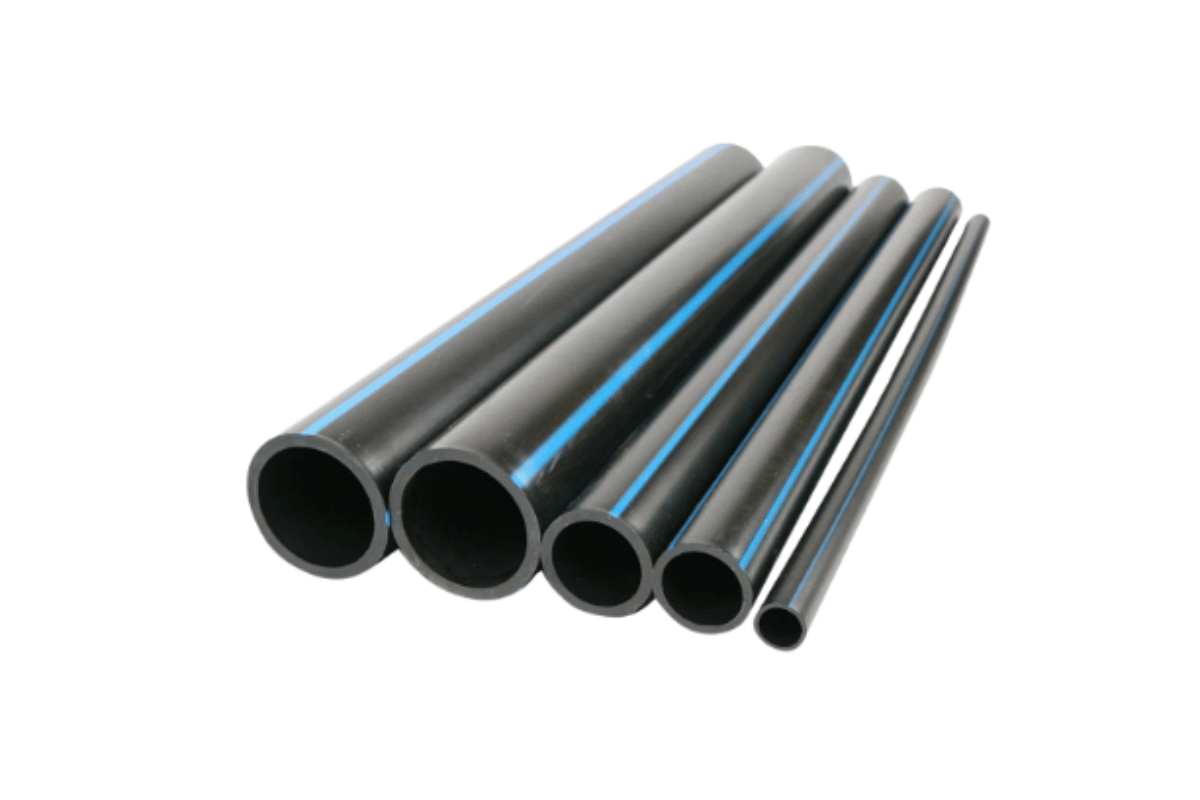
1. What is HDPE piping most commonly used for?
HDPE piping is widely used for water and gas distribution due to its durability, flexibility, and resistance to corrosion. It’s also favored for its ease of installation and longevity in various environmental conditions.
2. How does HDPE piping withstand temperature fluctuations?
HDPE pipes can tolerate various temperatures, from freezing to extreme heat, without cracking or losing integrity. Their elasticity and impact resistance contribute to their performance in varied climates.
3. Are HDPE pipes environmentally friendly?
Yes, HDPE pipes are environmentally friendly. They are non-toxic, resistant to chemicals, and can be recycled. Their production and installation have a lower environmental impact than traditional piping materials.
4. How long can HDPE piping last once installed?
HDPE piping systems are designed to last 50 to 100 years, depending on the specific application and environmental factors, making them a cost-effective choice in the long run.
5. Can HDPE pipes be used for both above-ground and underground applications?
HDPE pipes are versatile and suitable for above-ground and underground use. Their resistance to UV light also makes them reliable for outdoor installations.





